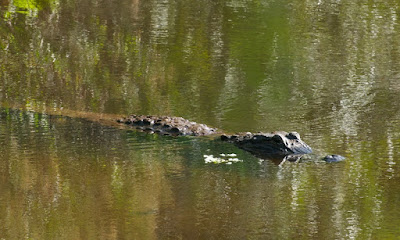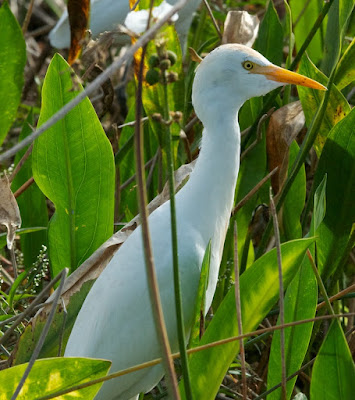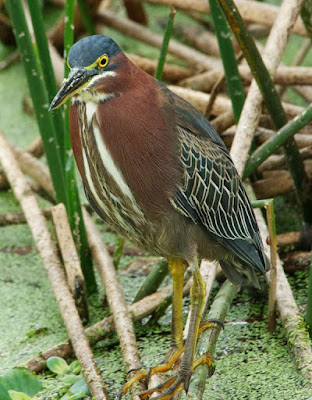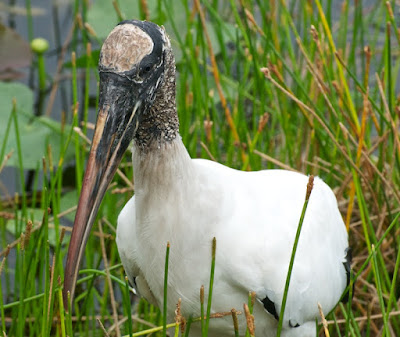By the time I came across the scene the snake was already dead, and hung limply from the heron's bill. How the hero had dispatched it - with a stab, a severe shake, or simply by bashing it against something, I cannot say - but the bird now faced a larger problem. How was it to swallow its prey?
The problem appeared to be giving the heron considerable pause for thought, as it spent a great deal of time simply standing there contemplating the issue.
However, prey is not worth much unless swallowed, and the job of transferring snake to stomach eventually got under way. That involved arranging it in the right position. Herons, unlike (say) hawks or falcons, do not have tearing beaks and must swallow their prey whole. Starting at the head end is the safest way to proceed, as it avoids the risk of being snagged on backward-facing scales.
Even once swallowing had begun, it took the bird a considerable amount of time to complete the job. As one of the reasons Eileen and I go to Green Cay is to get some exercise, at one point I abandoned bird and prey to do a circuit around the boardwalk. When I returned the tail end of the snake was stil protruding from the heron's beak.
At length, though, the snake completed its transit to the heron's interior, and after a few minutes the bird, presumably relieved that the whole process was over, stalked off for a rest.
As for reptiles eating herons, I have never seen this happen but an American Alligator (Alligator mississippiensis) must surely have the opportunity now and again...
....and I suppose that the odd chick of one of the smaller herons must occasionally disappear down the gullet of a Florida Softshell Turtle (Apalone ferox). These Florida Red-bellied Turtles (Pseudemys nelsoni), however, are primarily vegetarians.
Great Blue Herons, the largest in North America, are regular reptile-eaters, and will take both turtles and young alligators when they get the chance.
When not on the hunt, or simply standing around, they are diligent nest-tenders. This pair at Wakodahatchee nest on a small islet with a nearby viewing platform, where they are extensively and thoroughly photographed.
Next down in the size scale is the Great Egret (Ardea alba), also an active predator (I have seen them take baby birds in addition to their more usual fishes, frogs and other items).
Like other herons, Cattle Egrets (Bubulcus ibis) will eat almost anything they can catch. Being much more terrestrial in their feeding habits than other herons, though, they concentrate primarily on insects.
Snowy Egrets (Egretta thula), by contrast, hunt mostly in the water, where they catch small insects, frogs, crustaceans, aquatic insects and the like.
They are certainly the most graceful of the lot!
Tricolored Herons (Egretta tricolor) are probably the easiest of the wetland herons to approach, perhaps because they perch regularly on the boardwalk railings and seem only slightly concerned by the human parade that passes them. As its particularly long and spear-like bill suggests, this is primarily a fish-eater.
Green Herons (Butorides virescens) not only fish, but have been known to attract their prey by putting out bait on the water's surface.
The largest wading bird in the area, though, is not the Great Blue Heron but the Wood Stork (Mycteria americana). Like herons, Wood Storks will feed on a wide range of fishes reptiles, invertebrates and what have you, including such delicacies as mice and baby alligators.
They lack the herons' stabbing bills, of course, and their hunting technique is entirely different. According to the US Fish and Wildlife Service, "Wood storks capture their prey by a specialized technique known as grope-feeding or tacto-location. Feeding often occurs in water 6 to 10 inches deep, where a stork probes with the bill partly open. When a fish touches the bill it quickly snaps shut. The average response time of this reflex is 25 milliseconds, making it one of the fastest reflexes known in vertebrates."
By now, my alert readers will have realized that this post , despite its lead item, is something of a miscellany. That gives me a chance to fill it out with a few photos that don't quite fit in elsewhere, including this shot of a Brown Basilisk (Basiliscus vittatus) in my mother's back garden in Boca Raton. This is an introduced, tropical American lizard, famous for its ability to run across the surface of the water (hence its local Latin American name, "Jesus Christ lizard").
At least the basilisk is a reptile. I have no real reason for including this Paper Wasp (Polistes major) here, except that it is an attractive insect and I rather like the shot.
This, at least, is a Great Blue Heron, and I am using it (rather sneakily) to introduce a few more photos not taken at either Wakodahatchee or Green Cay.
We found the heron while doing a bit of exploring south of Boca Raton on December 24, 2013, along a suburban road dead-ending at a bit of sawgrass marsh that forms part of the Everglades Wildlife Management Area.
It was late morning and fairly hot, and there wasn't much about, but I did find this pair of Monk Parakeets (Myiopsitta monachus), another introduced species, nuzzling each other in a tree overhead (the technical term for birds doing this is allopreening).
There were, however, lots of Black Vultures (Coragyps atratus) about, most of them circling overhead sunning themselves on a tile roof (where it must have been quite hot indeed).
At one point a few high-flying vultures were joined by an adult Bald Eagle (Haliaeetus leucocephalus). The Turkey Vulture (Cathartes aura) flying with it gives a good measure of the eagle's vast size.
I will end this post with a few more Black Vultures, stalking over someone's lawn: a reminder, perhaps, given the theme of predation at the beginning of this post, that sooner or later both hunter and hunted may disappear down the gullets of these guys.
When not on the hunt, or simply standing around, they are diligent nest-tenders. This pair at Wakodahatchee nest on a small islet with a nearby viewing platform, where they are extensively and thoroughly photographed.
Next down in the size scale is the Great Egret (Ardea alba), also an active predator (I have seen them take baby birds in addition to their more usual fishes, frogs and other items).
Like other herons, Cattle Egrets (Bubulcus ibis) will eat almost anything they can catch. Being much more terrestrial in their feeding habits than other herons, though, they concentrate primarily on insects.
Snowy Egrets (Egretta thula), by contrast, hunt mostly in the water, where they catch small insects, frogs, crustaceans, aquatic insects and the like.
They are certainly the most graceful of the lot!
Tricolored Herons (Egretta tricolor) are probably the easiest of the wetland herons to approach, perhaps because they perch regularly on the boardwalk railings and seem only slightly concerned by the human parade that passes them. As its particularly long and spear-like bill suggests, this is primarily a fish-eater.
Green Herons (Butorides virescens) not only fish, but have been known to attract their prey by putting out bait on the water's surface.
The largest wading bird in the area, though, is not the Great Blue Heron but the Wood Stork (Mycteria americana). Like herons, Wood Storks will feed on a wide range of fishes reptiles, invertebrates and what have you, including such delicacies as mice and baby alligators.
They lack the herons' stabbing bills, of course, and their hunting technique is entirely different. According to the US Fish and Wildlife Service, "Wood storks capture their prey by a specialized technique known as grope-feeding or tacto-location. Feeding often occurs in water 6 to 10 inches deep, where a stork probes with the bill partly open. When a fish touches the bill it quickly snaps shut. The average response time of this reflex is 25 milliseconds, making it one of the fastest reflexes known in vertebrates."
By now, my alert readers will have realized that this post , despite its lead item, is something of a miscellany. That gives me a chance to fill it out with a few photos that don't quite fit in elsewhere, including this shot of a Brown Basilisk (Basiliscus vittatus) in my mother's back garden in Boca Raton. This is an introduced, tropical American lizard, famous for its ability to run across the surface of the water (hence its local Latin American name, "Jesus Christ lizard").
At least the basilisk is a reptile. I have no real reason for including this Paper Wasp (Polistes major) here, except that it is an attractive insect and I rather like the shot.
This, at least, is a Great Blue Heron, and I am using it (rather sneakily) to introduce a few more photos not taken at either Wakodahatchee or Green Cay.
We found the heron while doing a bit of exploring south of Boca Raton on December 24, 2013, along a suburban road dead-ending at a bit of sawgrass marsh that forms part of the Everglades Wildlife Management Area.
It was late morning and fairly hot, and there wasn't much about, but I did find this pair of Monk Parakeets (Myiopsitta monachus), another introduced species, nuzzling each other in a tree overhead (the technical term for birds doing this is allopreening).
There were, however, lots of Black Vultures (Coragyps atratus) about, most of them circling overhead sunning themselves on a tile roof (where it must have been quite hot indeed).
At one point a few high-flying vultures were joined by an adult Bald Eagle (Haliaeetus leucocephalus). The Turkey Vulture (Cathartes aura) flying with it gives a good measure of the eagle's vast size.
I will end this post with a few more Black Vultures, stalking over someone's lawn: a reminder, perhaps, given the theme of predation at the beginning of this post, that sooner or later both hunter and hunted may disappear down the gullets of these guys.















































No comments:
Post a Comment